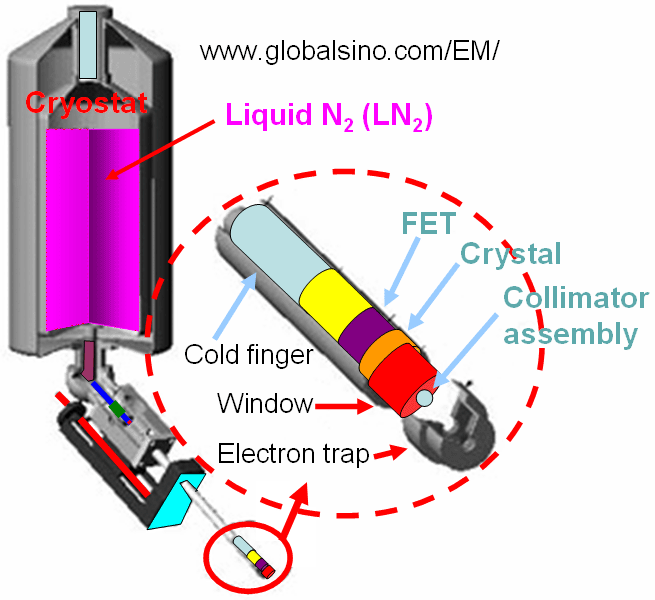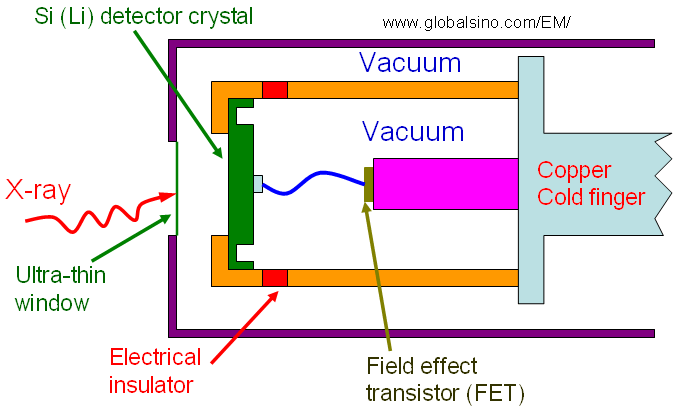=================================================================================
The beryllium window on the conventional EDS detectors absorbed X-rays significantly, especially for the elements with atomic number ≤ 11. To detect the chemical elements with atomic number (Z) down to boron (B), the ultrathin window (UTW) and atmospheric pressure window (ATW) had been developed. The so-called UTW detectors are a compromise between `windowless' EDS detectors and beryllium `window' EDS detectors. Figure 3923a shows the schematic illustration of an EDS detector.

Figure 3923a. Schematic illustration of EDS detector.
The solid-state EDS detectors are attached to the columns of the electron microscopes and normally consist of a collimator, window, lithium-drifted silicon detector, field effect transistor (FET), Dewar, and preamp as shown in Figure 3923b.

Figure 3923b. Schematic illustration of basic structure of an EDS detector with a solid state crystal and an ultra-thin window (UTW).
The UTW detectors normally employ a gold (Au)-coated Formvar film in thickness of a few tens of nanometers or an aluminum-evaporated organic film in thickness of 0.3 to 0.5 μm. This film protects the detectors but absorbs low-energy X-rays much less than those with conventional Be window, and thus permits detection of X-rays from boron (Z=5) to high-atomic-number elements. The disadvantage of these detectors is that the ultra-thin window cannot maintain the pressure difference between the internal detector vacuum and the atmospheric pressure; therefore, an airlock set is needed to protect the window when the microscope vacuum is broken. On the other hand, the X-ray collection efficiency is decreased because the EDS detectors cannot be positioned close to the specimen due to the airlock mechanism and the magnetic electron trap.
Table 3923. Comparison of various windows for EDS detectors.
Model |
Windowless |
Ultra-thin window |
Atmospheric thin window |
Beryllium/polymer window |
Windows thickness |
0 nm |
100 -
300 nm |
300 nm |
5 - 7 µm |
Windows material |
None |
Polymer |
Low density plastic, diamond, or polymer on grid |
Be |
Elements detected |
Z ≥ 3 (Li) |
|
Z ≥ 3 (Li) |
Z ≥ 11 (Na) |
Advantage |
No absorption; better sensitivity for light-element detection (that can record X-rays from elements as light as Be) |
Lower absorption than those with conventional Be window; permits detection of X-rays from boron to high-atomic-number elements; X-ray collection efficiency is decreased. |
Robust; absorb far fewer of low-energy X-rays than does the Be window |
Is a protective barrier between the vacuum of the specimen chamber and the detector crystal; robust. |
Disadvantage |
Contamination (gradual condensation of hydrocarbons and/or ice on the cooled detector crystal), light transmitted, need UHV |
Cannot maintain the pressure difference between the internal detector vacuum and the atmospheric pressure; breaks easily |
Less effective area |
Be window is the primary absorber of low-energy X-ray; X-rays from elements below an atomic number of 11 are absorbed by beryllium and are not detected.
|
Since the window material is very thin, a special attention is also needed when the detector is attached to and detached from the microscope column.
|